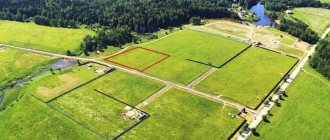The turnover of plots intended for agriculture is under increased state control.
Such territories must be processed in a timely manner and used for their intended purpose in order to maintain the country’s food security.
How to correctly arrange a purchase with a private person or with the state? What documents need to be prepared and how to draw up an agreement? Detailed information is below in the article.
Legal regulation
The main regulatory act is Law No. 101-FZ of July 24, 2002 “On the turnover of agricultural land.”
This document describes:
- peculiarities of turnover of such areas;
- grounds for seizure;
- maximum plot sizes;
- rights of foreign citizens in the field of purchase and use of agricultural plots;
- other rules.
Reference! On all issues not regulated by Law No. 101-FZ, one should be guided by the norms of the Land Code of the Russian Federation.
The provisions of federal legislation may be supplemented at the local level. For example, Law of the Altai Territory No. 8-3C of March 14, 2003 “On the regulation of certain relations in the field of turnover of agricultural land” contains rules that clarify the procedure for notification by the owner of a subject of the federation of the intention to sell an agricultural plot.
Preemptive right to acquire land for agricultural purposes
By law, the owner of the plot must notify the subject of the federation that he wishes to sell the agricultural plot. The state has a pre-emptive right to purchase at a price set by the seller himself. The notice is issued in free form.
The document states:
information about the owner (full name or name of organization, place of residence/location, telephone number);- the name and address of the executive authority of the subject of the federation to which the notice is submitted;
- an indication that the author of the document wishes to sell land classified as agricultural and owned by him;
- information about the site - location (address or landmarks by which it can be identified), area, cadastral number;
- mutual settlement period;
- the address to which the recipient should send the response;
- date, signature, surname and initials.
The period for making mutual settlements under such an agreement should not exceed 90 days.
Attached to the notice:
- copy of the cadastral plan;
- a copy of the certificate of ownership.
Within 30 days, the government agency makes a decision on concluding a transaction or refusing to buy out. The response is sent to the owner. If the owner receives a refusal or written notice was not sent within the specified period, an agreement can be concluded with another buyer.
Important! The preemptive right is not used if the site is sold at public auction or withdrawn for government needs.
If the land owner has not found a buyer who can pay the established price, and it had to be reduced, the notice must be sent to the government agency again.
The owner of the site does not have the right to ignore the described procedure. In this case, the transaction is considered void from the moment of conclusion.
Transaction with a private person
When purchasing a plot of land, sellers require:
Extract from the Unified State Register of Real Estate . The document indicates who is the owner of the site, there is information about its area, permitted land use, and current encumbrances.- Boundary plan - using this document you can clarify the boundaries of the allotment.
- Citizen's passport. You need to make sure that negotiations are with the real owner of the land. The contract must also indicate the exact passport details of the seller.
- Certificate from the BTI about the presence of buildings. It is necessary to check whether any structures have been erected without permission.
- A certificate from the PND stating that the seller is not registered. A citizen may turn out to be mentally ill, unable to understand the consequences of his actions, which may lead to the cancellation of the transaction.
- Written refusal of a government agency to purchase an allotment. Its presence will confirm that the procedure for notifying the subject of the federation about the sale has been followed. If there is no document, you need to request a postal document confirming the sending of registered mail.
Not every person can own a piece of agricultural land.
Cannot become a buyer:
- foreign citizen;
- a person whose area of available land after purchase exceeds the limit established at the level of the subject of the federation;
- other persons in accordance with the law.
If all documents are satisfactory to the seller, the parties proceed to signing the contract.
The agreement specifies:
- name of the document, place of execution, date;
- information about the parties (full name, date of birth, place of residence, passport details);
- subject of the agreement – transfer of ownership of the site on a reimbursable basis;
- description of the site (address, area, permitted use, cadastral number);
- cost, conditions and payment procedure;
- rights and obligations of the parties;
- procedure for transfer of ownership;
- liability measures;
- other provisions;
- details and signatures.
An act of acceptance and transfer of the site is also drawn up, unless otherwise provided in the agreement. Next comes state registration.
The parties themselves agree on who is responsible for registering the transaction in Rosreestr. Usually the buyer takes care of this formality and bears the associated costs.
A citizen applies to the local office of Rosreestr and
submits the following documents:
- personal passport;
- application (filled out on site using a template);
- 2 originals of the purchase and sale agreement;
- act of acceptance and transfer of land.
A person must also transfer a fee of 2,000 rubles to the budget.
The registrar checks the documents. If there are no complaints, then the application is accepted. Information is entered into the Unified State Register within 10 working days . After this, the citizen will be returned 1 original contract with a note indicating that registration has been completed. Additionally, an extract from the Unified State Register can be issued, where the applicant is indicated as the owner.
On a note! A citizen can also submit documents through the MFC, but the procedure will drag on for the period of sending the papers to Rosreestr and back.
Share allocation in kind
This is where the fun begins. Where is this share actually? How to highlight it in kind in 2021, given that most of the suitable places are already occupied by other users?
The procedure for allotment in kind is subject to the norms for the formation of plots and occurs in accordance with the Land Code of the Russian Federation and Federal Law No. 101-FZ.
Stages of share allocation:
- To exercise the right to allocate a share in kind, the first step is to select a place where it can be located. Perhaps this will be the most important and most difficult part of the procedure.
It is necessary to select a site based on data from contour sheets (they can be requested from the Rosreestr Office) and other cartographic material that contains information about the location of the former agricultural enterprise.
Only if no graphical data exists can you search for a suitable location on the Public Cadastral Map in the area where the site is located. It is very important to correctly form the site within the boundaries: it should not be occupied by farmland, on-farm roads, communications that belong to the property of the constituent entities of the Russian Federation. The formed area should not be located outside the boundaries of cultivated farmland. The choice of a place where it is possible to form a plot of agricultural land should be approached very responsibly. It happens that even the authorities make claims against areas allocated and registered within the boundaries, for example, if the formed area has taken over a forest belt. The authorized authority has the right to sue the owner of such a plot.
- When a suitable location has been found, you need to prepare a land surveying project. This is what cadastral engineers do.
- The next mandatory stage of the process is the publication of a notice about the allocation of a share in kind: the cadastral number of the plot from which the allocation is being made, the owner’s full name, and address are indicated. With this notification, co-owners are notified that it is necessary to familiarize themselves with the location of the allocated plot and agree on it. To submit justified objections to the address indicated in the publication, the law allows 30 days.
The notice is submitted to the local newspaper, which publishes official information by local government bodies. This procedure is regulated by clauses 10-14 of Art. 13.1 No. 101-FZ.
If the remaining participants in shared ownership have not contacted the cadastral engineer, you can proceed to the next stage.
- If there are no objections, the land surveying project is considered agreed upon and certified by the owner of the share.
- A boundary plan is prepared, which includes a graphic part that establishes the exact location of the allocated farmland. The land surveying project is an integral part of the land survey plan, the newspaper is an appendix to it.
If there are less than 6 co-owners, you will additionally need an agreement on allotment, or a copy of the minutes of the general meeting of co-owners certified by a representative of the administration. This provision is provided for by Federal Law No. 218-FZ of July 13, 2015 “On State Registration of Real Estate”.
- The boundary plan is submitted to Rosreestr for registration of the share as an independent object and the emergence of the right to the formed plot. The right to a share in the common plot is canceled. An owner who wishes to carry out a spin-off has the right to submit an application to Rosreestr without co-owners.
After the allocation of the share in kind, the owner of the share will become the full owner of the plot formed within the boundaries. It will become even easier to manage such a plot, it can be easily rented out, and its value will increase.
If the owners of the land plot do not come to an agreement, you can go to court for the allocation of your share (Article 252 of the Civil Code of the Russian Federation).
The cost of work on allocating a plot, due to its complexity and duration, as well as the large size of the plot, is several times higher than the work on surveying ordinary plots of individual housing construction and gardens. If Rosreestr denies the formation of a plot due to its location outside the boundaries of farmland, the cadastral work will have to be redone and the publication resubmitted, which entails additional time and material costs.
Deal with the state
The procedure for acquiring municipal plots is regulated by the norms of the Land Code of the Russian Federation. Plots are sold at public auction or allocated without an auction.
Citizens can purchase registered plots and parts of undemarcated territory. In the 2nd case, the interested party is obliged to draw up a diagram of the location of the site on the cadastral plan of the territory and approve it.
After approval, cadastral work is carried out in order to form a plot and register it in the Unified State Register of Real Estate. To allocate a plot, you need to submit an application to the local government authority.
The appeal states:
name of the body to which the application is submitted (local committee for state property management);- document's name;
- FULL NAME. citizen, date of birth, passport details, SNILS, residential address, TIN (if any);
- postal address and telephone number for contact;
- request to provide a plot of land for agricultural production on the right of ownership on a reimbursable basis (or free of charge, if the citizen has such a right);
- information about the site (area, cadastral number, location, details of the decision to approve the land surveying project);
- details of the decision on preliminary approval of the provision of a land plot (if it was made);
- information on the basis for transferring ownership of the site without bidding;
- list of attached documents;
- date, signature, surname and initials.
Attached to the application:
- copy of the passport;
- a copy of documents giving the right to receive a plot without bidding;
- layout of the land plot (if it was drawn up).
The citizen's application is considered within 30 days. The period may be extended if the procedure requires the publication of information about the provision of a plot in the media or the submission of the issue to the interdepartmental commission on land and property relations of the region.
If the legal requirements are met, the citizen receives a notification of a positive decision. Otherwise, a reasoned refusal indicating the norms of the law that were violated.
If an interested party requests an auction for the sale of a plot, the relevant information must be indicated in the application. In the response, the government agency notifies about the date of the auction.
After this, a contract is drawn up. The document contains the following provisions:
details of the contract (name, date, number, place of execution);- information about the parties (name of the government body, full name and position of its representative, full name, date of birth, passport details of the buyer);
- subject of the transaction – transfer of ownership of a land plot;
- description of the plot (address, area, cadastral number, category of land, permitted land use);
- cost and payment procedure;
- rights and obligations of the parties;
- responsibility;
- other provisions;
- details and signatures.
Typically, the text of the contract is formed by employees of the local government. Citizens are provided with a ready-made template for signature.
Attention! If the ownership right is realized at auction, then the essential terms of the contract are described as specified in the conditions of the auction.
After signing the contract, a transfer and acceptance certificate is drawn up. The document confirms that the plot has passed into the ownership of the buyer, and he has no claims. At the end, the citizen applies to Rosreestr to register the transaction.
He must present:
- your passport;
- 2 originals of the contract;
- act of acceptance and transfer;
- application for registration of a transaction.
The registrar checks the available documents and accepts them. The procedure takes up to 10 working days. The necessary information is entered into the Unified State Register, and the citizen is returned a copy of the agreement with a registration mark.
Let's sum it up
A special feature of the procedure for registering land shares is the difficulty in realizing the right to actually use a plot without allocating it in kind. At the same time, a virtual share can be sold, bequeathed, donated, or left as an inheritance. At the moment, all land shares have already been transferred into the ownership of citizens and legal entities; they are the same subject of turnover as any other property. When selling an unallocated share, the remaining shareholders have the right of first refusal.
The allocation of a share in kind is carried out on the basis of a land surveying project and a land survey plan.
Read: Changes when registering a house on a garden plot in 2021










